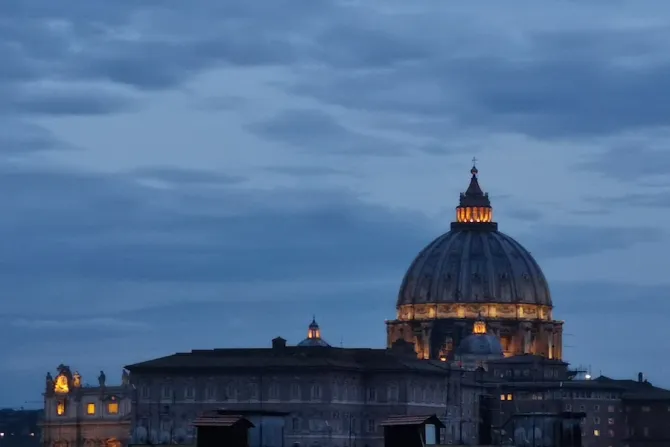Vatican City, Mar 13, 2020 / 12:47 pm
Less than one day after the Diocese of Rome closed all Roman churches to the public, the cardinal who oversees the diocese reversed himself, saying he would leave that decision to parish pastors.
Both announcements came amid deliberations between Pope Francis and Cardinal Angelo De Donatis, the vicar general of Rome, who oversees the day-to-day operations of a diocese whose bishop is Pope Francis.
De Donatis published a letter March 13 explaining that he consulted with Pope Francis before closing the churches for private prayer March 12, and before opening them again March 13.
"After consulting our bishop, Pope Francis, we published yesterday, March 12, the decree that establishes the closure of our churches for three weeks," Cardinal Angelo De Donatis wrote in a letter to the Diocese of Rome.
"A further conversation with Pope Francis, this morning, however, prompted us to consider another need: that because of the closure of our churches, other 'least ones' find a different kind of reason for uncertainty and confusion. The risk is for people to feel even more isolated," he explained.
Before the initial decision's reversal, Pope Francis had spoken out against "drastic measures" in response to the coronavirus in his morning homily televised throughout Italy and livestreamed online.
"Let's pray for this, that the Holy Spirit may give to pastors the ability for pastoral discernment so that they might provide measures which do not leave the holy, faithful people of God alone, and so that the people of God will feel accompanied by their pastors, comforted by the Word of God, by the sacraments, and by prayer," Pope Francis said March 13.
Pope Francis had prayed for authorities who "must decide … on measures that people do not like" in his homily the day prior.
In defiance of the initial church closure decree, the cardinal in charge of the pope's charity office, Cardinal Konrad Krajewski, opened Friday his titular church, St. Mary Immaculate all'Esquilino, a church located in an ethnically-diverse, and poor, area of Rome.
"In full compliance with safety standards, it is my right to ensure an open church for the poor. At 8:00 this morning, I came here and opened the door wide. In this way the poor will be able to adore the Blessed Sacrament which is the consolation for all in this moment of grave difficulty," Krajewski said, according to Vatican News.
The diocesan reversal came shortly after.
The revised decree clarifies that "non-parish churches" and other religious buildings will remain closed, while parishes and missionary churches dedicated to care for others can be reopened. The properties of religious communities and monasteries are only accessible to the members of their communities.
The decree "is therefore modified, placing the ultimate responsibility of entering the places of worship in the hands of priests and all the faithful, so as not to expose the population to any danger of contagion and at the same time avoid the sign of a physical prohibition on access to a place of worship by closing it, which could create disorientation and a greater sense of insecurity," Cardinal De Donatis wrote.
"Every ecclesial precautionary measure must take into account not only the common good of civil society, but also of that unique and precious good which is faith, especially that of the least ones," he said.
The vicar general exhorted Catholics to follow the Italian government's quarantine measures until April 3, and to stay at home.
"Coronavirus infection is spreading exponentially. In a few days the number of infected doubles, and at this rate it is not difficult to predict that in two months it will reach the order of tens of thousands of people only in Italy," De Donatis wrote in his letter.
(Story continues below)
"There is a clear risk of collapse of healthcare facilities, in which there are already many on ventilators, above all because of the disproportion between the available intensive care resources and the growing number of patients. A large number of people could die, especially the elderly and vulnerable people," the vicar of Rome said.
There are 242 confirmed cases of COVID-19 currently in Lazio, the region surrounding Rome, as of March 13, according to the Italian Ministry of Health.
Coronavirus cases in Italy have grown quickly in recent weeks surpassing 17,500 documented cases. More than 1,250 people have died from COVID-19 in the country since Feb. 22.
A nationwide quarantine has been declared in Italy through April 3 in order to slow the spread of the coronavirus pandemic.
The quarantine restricts movement within Italy and requires people to stay in their homes except for cases of absolute necessity, which may include going to work, to the pharmacy or hospital, or to the supermarket.
On March 11, Italy's Prime Minister Giuseppe Conte tightened the restrictions of a nationwide lockdown to include the closure of all restaurants, bars, and non-commercial businesses other than supermarkets.
In all cases, a distance of one meter must be maintained between people in public. Not following these regulations is punishable by fine or arrest.
The previous Diocese of Rome decree suspending all public Masses in the diocese until April 3 still stands, however now Catholics will once again have access to some parishes for private prayer.
"The spiritual need of the people of God to gather to celebrate the Eucharist becomes for us Christians the object of a painful renunciation. There is first the spiritual need for the charity of caring for our brothers. Unfortunately, going to church is no different than going to other places: it is at risk of contagion," De Donatis wrote.



